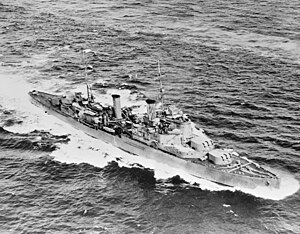HMS Fiji (C58)

Fiji in 1940
|
|
| History | |
|---|---|
|
|
|
| Name: | HMS Fiji |
| Namesake: | Colonial Fiji |
| Builder: | John Brown & Company, Clydebank |
| Laid down: | 30 March 1938 |
| Launched: | 31 May 1939 |
| Commissioned: | 5 May 1940 |
| Identification: | Pennant number 58 |
| Fate: | Sunk 22 May 1941 by German bombers, south west of Crete |
| General characteristics | |
| Class and type: | Crown Colony-class light cruiser |
| Displacement: |
|
| Length: | 169.3 m (555 ft) |
| Beam: | 18.9 m (62 ft) |
| Draught: | 5 m (16 ft) |
| Propulsion: |
|
| Speed: | 33 knots (61 km/h) |
| Range: | 6,520 nmi (12,080 km) at 13 kn (24 km/h) |
| Complement: | 730 |
| Sensors and processing systems: |
High Angle Control System, Type 279 Radar |
| Armament: |
|
| Armour: |
|
| Aircraft carried: | Two Supermarine Walrus aircraft. |
HMS Fiji was a Crown Colony-class light cruiser of the Royal Navy, named after the island group, and at that time, the Crown colony of Fiji. She has been the only ship of the Royal Navy to bear the name.
Fiji was built by John Brown and launched on 31 May 1939. She was the first of the Crown Colony class to enter service, and the class is sometimes known as the Fiji class as a consequence. She was commissioned on 5 May 1940, and initially joined the Home Fleet. On 31 August 1940 she sailed for the African Atlantic coast to take part in Operation Menace, the attack on Dakar. Before she could join the taskforce, Fiji was damaged by a torpedo from the German submarine U-32 on 1 September and had to return to Britain for repairs, which lasted for the next six months. She was fitted with radar and her Anti-Aircraft armament was also marginally increased.
She returned to service in March 1941 and was assigned to patrol the Denmark Strait for German raiders. She missed the homeward bound German cruiser Admiral Scheer, and in April she was reassigned to Force H to blockade the German heavy ships then stationed at Brest. With Force H, she sailed into the Mediterranean to support operations to relieve the island of Malta.
On completion of these duties she participated in the Battle of Crete. On 22 May 1941 she was acting in company with the destroyers Kandahar and Kingston shortly after the loss of the cruiser Gloucester. These ships fought on and shot down one attacker and damaged two others. She finally expended all of her anti-aircraft ammunition fighting off numerous air attacks that persisted for two hours. She was attacked and hit by several bombs from Messerschmitt Bf 109s of LG2 before an aircraft of Jagdgeschwader 77 dropped a bomb close alongside to port. This blew in Fiji’s bottom plates and caused a list to port. Fiji lost power and came to a standstill. She was now largely defenceless, having practically exhausted her 4 inch ammunition. She was then hit by three bombs dropped by a Junkers Ju 88 from Lehrgeschwader 1 piloted by Gerhard Brenner. Captain Peveril William-Powlett gave the order to abandon ship and Fiji rolled over and sank. The destroyers dropped floats and withdrew to the south. They returned after dark to pick up 523 survivors. 241 men were killed when the ship sank to the sea floor.
...
Wikipedia
